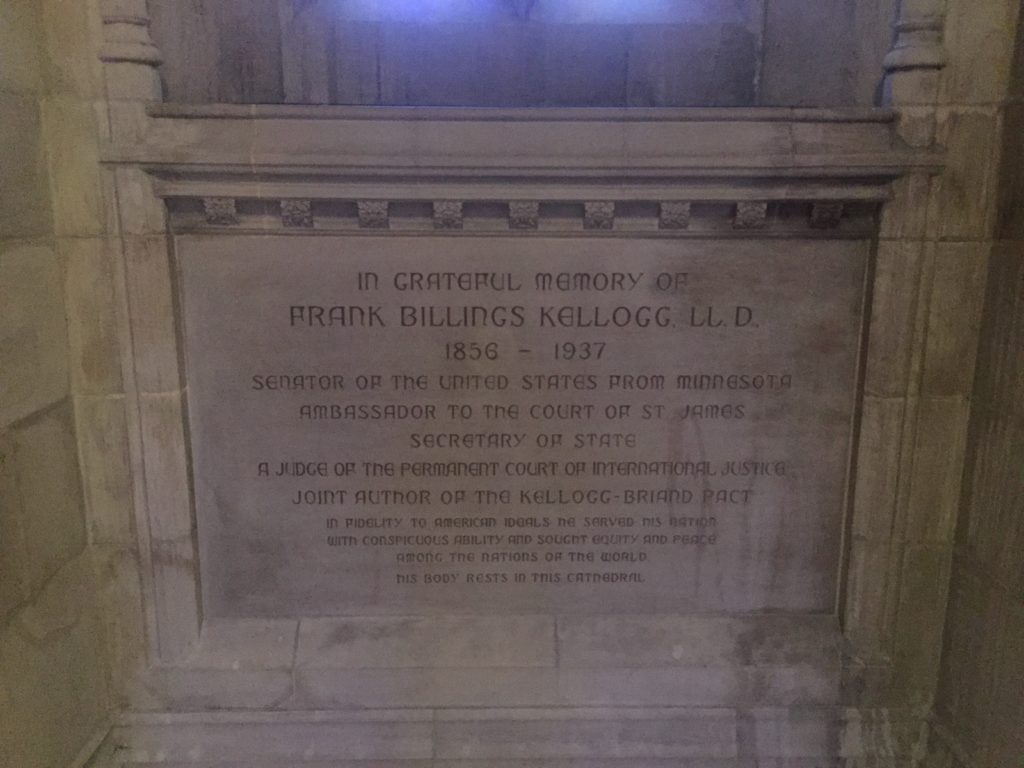Erik Visits an American Grave, Part 649
This is the grave of Frank Kellogg.

Born in Potsdam, New York in 1856, Kellogg spent the first part of his childhood there before his family moved to Minnesota in 1865. He grew up pretty poor, as his parents were not overly prosperous farmers. He had to drop out of school in 1870, when his father became too sick to run the farm. Bu a very determined young man, he went into the law, despite lacking a formal education, and began practicing in Rochester, Minnesota in 1877. He did very well, serving as city attorney for Rochester from 1878-81 and then county attorney for Olmsted County from 1882-87. He then became a leading corporate lawyer in Minnesota, representing major clients such as railroad capitalist James J. Hill.
In 1905, President Theodore Roosevelt named Kellogg to prosecute one of his trustbusting cases, against the Western Paper Trust. Winning that case, he then investigated E.H. Harriman, the railroad magnate. Kellogg led the prosecution against the Union Pacific in 1908. He then led a successful case against Standard Oil in 1911, prosecuting the case before the Supreme Court. As the leading trustbusting lawyer in the country, he was elected president of the American Bar Association for the 1912-13 term. He also served as a member of the Republican National Committee from 1904-12.
Now a leading Republican, Kellogg decided to run for the Senate from Minnesota in 1916. He won, serving one term as the first democratically elected senator in the state’s history after the ratification of the Seventeenth Amendment. His most notable action during that term was being one of the few Republicans to support the League of Nations and the Treaty of Versailles. However, he lost his reelection bid in 1922. With his elected career over though, he became a very useful person in the foreign policy establishment. He was named a delegate to the Fifth International Conference of American States in Santiago, Chile in 1923 and then was named ambassador to Britain in 1924.
In 1925, with Coolidge having won a full term, he called Kellogg home to be Secretary of State. He was a pretty active official, particularly engaging in the peace efforts that marked the interwar period. He is most famous today for his role in the Kellogg-Briand Pact. This 1928 agreement, worked out with French foreign minister Aristide Briand, declared that nations which signed the agreement would not solve their problems with each other through war. Briand had approached Kellogg about the U.S. and France signing a bilateral agreement to ban war, but Kellogg believed it would only be effective if it was truly multilateral. Certainly, the effective outlawing of war did not work out, as Germany, a signatory to the treaty, would demonstrate a decade later. Stephen Walt argues it was a total failure, for instance. But the principle of international cooperation over war was an important one and though the U.S. never did join the League of Nations and Kellogg-Briand was not associated with the League, its principles played an important role in the shaping of the United Nations after World War II and was the legal basis for the trials against German and Japanese leaders. For his work on this, Kellogg won the 1929 Nobel Peace Prize.
Kellogg was particularly interested in Latin America. He worked hard to better U.S.-Mexican relations and attempted to mediate the Cristero Rebellion, which was a war between the Mexican revolutionary state and the Catholic Church that really extended the revolution and its destruction an extra decade. He also set up the negotiations in Washington to settle the long-standing border dispute between Peru and Chile that split the disputed land in the Treaty of Lima in 1929. He did sign off on sending U.S. troops to Nicaragua, again, but really did not want to and preferred a peaceable approach to conflict with Latin America that would turn the nation away from the Dollar Diplomacy of Taft and Elihu Root.
After Hoover’s election, Kellogg became a judge on Permanent Court of International Justice in 1930, staying there until 1935. He died in 1937 at home in St. Paul, the day before his 81st birthday.
Frank Kellogg is buried in Washington National Cathedral, Washington, D.C.
If you would like this series to visit other Secretaries of State, you can donate to cover the required expenses here. Henry Stimson, who replaced Kellogg, is in Laurel Hollow, New York and Edward Stettinius is in Locust Valley, New York. Previous posts in this series are archived here.


